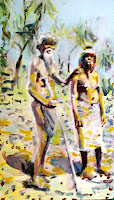Before I started to write this blog entry I spent a few hours researching the numerous facts I intend to use. Since publishing all the written commentaries for the Top 100 (by means of this blog, but also the catalog for the Top 100 2009 —see previous blog entry), I try to make it a habit to check all facts. A good habit I believe :), as I did make numerous silly mistakes in the past. My memory may make for an interesting story but not necessarily a true one. Some years ago I had Van Morrison, for example, incorrectly born in Dublin in stead of Belfast :( . I'm glad too, I had checked my sources in a recent blog entry on Nina Simone, when the author of an article I quoted from checked in on me. Saved myself an embarrassment there :D.
Anyhoo, I was checking the facts on this recording by Edison and it turns out that sound had been recorded seventeen years earlier by the French inventor Edouard-Léon Scott de Martinville. His recording was of a female voice singing Au Clair de la Lune. But honor to whom it deserves: The French recording was never audible until American researchers managed to transcribe the data (and cleaned it up in the process), while Edison's instantly played back. But I do like Au Clair de la Lune a whole lot better than Mary Had a Little Lamb. The song -now audible and accessible-, as a matter of fact, scored a few points in my last top 10. That happening truly reinforced my claim that the music in the Top 100 is an account from the history of recorded sound.
Why was I checking the facts on Edison? Because I was preparing a written commentary on a recording of aborigines wailing made by Prof. A.C. Haddon of the 1898 Cambridge Anthropological Expedition. The recording, aptly titled The 1898 Torres Strait Death Wail, is the oldest to feature in a Top 100. It did so last year and returns this year. The oldest recording used to be a recording of Swift Flying Feather performing a love song made in Minnesota in 1899. The death wail is an absolute gorgeous recording. It is eerie (upon first hearing one may think it's an under water recording of the sounds of humpback whales), unhuman sounding, but so human and musical too. It was recorded on a wax cylinder
 only 21 years after Edison's first but 11 years after Emile Berliner's invention of the (flat) phonograph record. While recordings were being made, using this crisp sounding technology, of opera singers and folk ensembles on both sides of the Atlantic, the Torres Strait recordings sound gritty at best.
only 21 years after Edison's first but 11 years after Emile Berliner's invention of the (flat) phonograph record. While recordings were being made, using this crisp sounding technology, of opera singers and folk ensembles on both sides of the Atlantic, the Torres Strait recordings sound gritty at best.Veteran Minnasie Chief and Daughter-in-law, Marrakai Plains, Northern Teritory
14" x 8"
oil on wood, 2010 (from an original 1915 photograph)
14" x 8"
oil on wood, 2010 (from an original 1915 photograph)
No comments:
Post a Comment